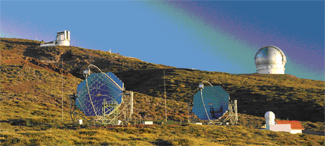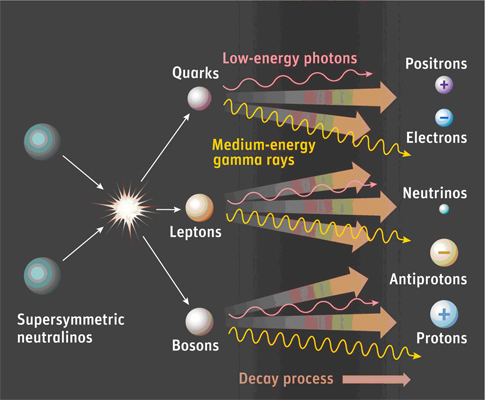Physics

MAGIC telescope sheds light on the understanding of dark matter
Dark matter is the major component of Universe: there is four times more dark matter than normal matter. But it is quite unknown: it does not emit or absorb light directly, but has a very important gravitational effect. However, when two dark matter particles collide, they may annihilate and produce different particles, including gamma-rays, which are photons million times more energetic than visible light and which can be detected by instruments like the MAGIC telescope, a European experiment located on the Canary Island of La Palma (Spain). This article, in wich UAB researchers participated, presents searches for dark matter using MAGIC by observing the object believed to be the most dark matter dominated in the vecinities of our own galaxy: a satellite galaxy of the Milky Way called Segue 1.
References
“Searches for dark matter annihilation signatures in the Segue 1 satellite galaxy with the MAGIC-I telescope”. The MAGIC Collaboration (Aleksic J. et al), Journal of Cosmology and Astroparticle Physics 06, 2011, pp. 035.
The knowledge that the Earth is only a tiny spot in the Universe is known by many of us, but surely less people know that all the matter that forms our bodies, the Earth and the stars and that is described by physicists with the Standard Model of Particles is only a small fraction of the total matter present in the Universe. There is four times more dark matter than "standard" matter, and we don’t have any clue about its nature: how much do they weigh? How exactly do they interact? There are hypotheses, but no proven theories that could explain this new kind of matter, called “dark matter”.
There are several reasons that motivate our ignorance: the dark matter, as the name suggests, does not emit or absorb light directly but only attracts other matter gravitationally. These gravitational effects are known since the beginning of the last century, but in the last decades, more and more evidences have been accumulated and now precise estimations on the amount of dark matter in the whole Universe are known. We also know that each Galaxy is embedded into a ten-times bigger spherical bubble (called halo) of DM, like a dense cloud. We live inside the cloud, but so far we cannot see it directly.
There are several tens of models proposed to explain the nature of dark matter, but none has been verified until now. The most popular is the Super-Symmetric scenario, a theory which is currently under validation at the Large Hadron Collider at Cern, which foresees that each standard particle has an elusive (super-symmetric) partner that can be seen only at extremely high energies. In this theory, the dark matter particle is also called “neutralino”.
When two neutralinos collide, as happens with standard particles, they can annihilate. Annihilation means that the two particles disappear and give birth to other particles, like quarks, electrons, neutrinos…and gamma-rays. Gamma-rays are photons of light but of roughly a billion times higher energy.
While dark matter is expected everywhere in the Universe, we expect there are places where it is very much condensed. These are for example, the Galactic Centre, the dwarf satellite galaxies that turn around the Milky Way, clusters of galaxies, etc. By observing these objects, one may expect to see some gamma-ray radiation coming from dark matter annihilations.
The MAGIC experiment is a system of two telescopes that observe the cosmic gamma-ray emission. It is located in Spain (Canary Island of La Palma) and is working since 2004. It is a European experiment to which Spanish institutes contribute with about 50 scientists and played a major role in the construction and scientific exploitation.
The Grup de Fisica de Radiacions of the Department of Physics participate in MAGIC since the early design phase (with Lluís Font Guiteras as responsible). The group is responsible for the atmospheric monitoring, and actively involved in atmospheric calibration. It also coordinates the dark matter search program in MAGIC, and expert in galactic objects and gamma-ray bursts physics. The Campus also hosts two large MAGIC group members: the Institut de Fisica d’Altes Energies (IFAE), , and the Instituto de Ciencias del Espacio (IEEC-CSIC). MAGIC is currently the worldwide largest telescope of this kind with two parabolic mirrors of 17 m diameter.
Gamma-rays are typically produced in catastrophic events like stellar explosions, black hole phenomena, fast-spinning neutron stars and so on. The amount of energy produced during such processes is that of a billion billions MWh power plants at once. Recently, we published a study about the MAGIC observation of what is considered one of the best candidate for dark matter searches in the sky: a dwarf satellite galaxy called Segue 1. This galaxy weighs less less than a thousandth of our Galaxy, but is a thousand times denser than our galaxy, and we believe this is due to large presence of dark matter there. Despite no signal was found from this target by MAGIC, in our study we show how a null-detection can be used to discard some of the models proposed by scientists as dark matter candidates.
Great expectations for the detection of dark matter are expected in the next years once the LHC will reach the maximum luminosities. Nevertheless, the scientific community is more and more convinced that the LHC results alone will not be able to unveil the real nature of dark matter and also that different experiments are needed to confirm the results. For this reason, MAGIC will continue to make efforts towards a dark matter detection from the sky.

Illustration of the main annihilation channels for the neutralino, a good candidated for dark matter particles.
Michele Doro
Department of Physics
2024 Universitat Autònoma de Barcelona
B.11870-2012 ISSN: 2014-6388
